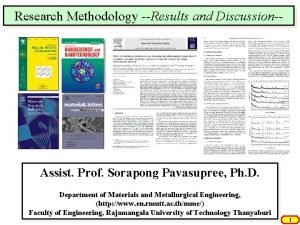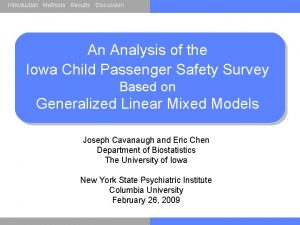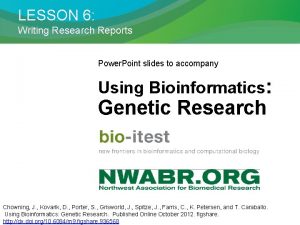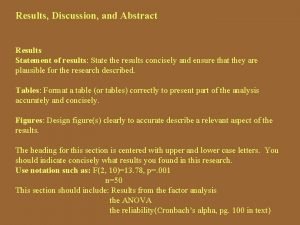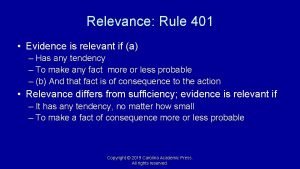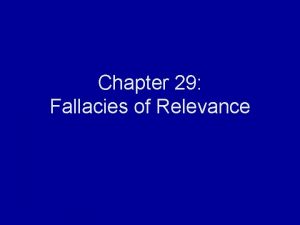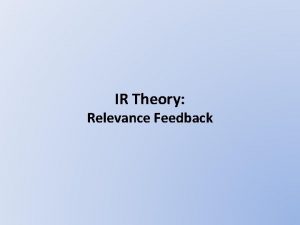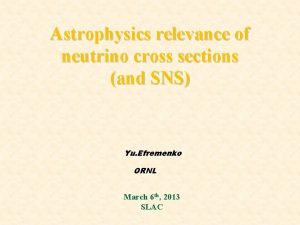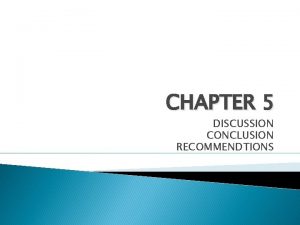Relevance of findings in Results to Discussion sections

















- Slides: 17

Relevance of findings in Results to Discussion sections in applied linguistics research Doing Research in Applied Linguistics April 22, 2011 Punjaporn Pojanapunya Richard Watson Todd

• Writing research articles is difficult • Discussions & Literature reviews are most difficult to write • Difficulty in writing discussions ▫ Language proficiency ▫ Genre ▫ Content (Bitchener & Basturkmen, 2006)

Content in discussions • Discussions involve “commenting on results” (Lim, 2010; Basturkmen, 2009), but how is this organised? ▫ Genre �e. g. reporting results, summarising results, commenting on results ▫ Results discussed

Research questions 1. What findings are reported in the discussion section of articles? 2. What functions of discussion sections are these findings reported in?

Data • Results and Discussion sections of 10 research articles ▫ Quantitative research articles ▫ Explicit RQs ▫ IMRD structure

Analysing Results • Identify each individual finding • Match each finding to the relevant RQ • Identify if the specific finding: ▫ answers or is relevant to an RQ ▫ answers more than one RQ ▫ is not relevant to the RQs

Analysing Discussion sections • Identify all findings reported in discussions • Identify how the findings are reported in terms of level of detail • Analyse genre move in discussions Presenting new findings Repeating purpose Repeating findings Contributions to the field Linking to literature about the research methodology Linking to real-world applications/practical recommendations Discussing limitations of the study Pointing to directions for future research Explaining reasons for the finding • Match findings with genre moves

Results RQ 1: What findings are reported in the discussion section of articles? RAs 1 No. of Findings in R 8 No. of Findings in D 5 Percentage of findings in R which are discussed in D 62. 50 2 28 11 39. 29 3 33 7 21. 21 4 55 11 20. 00 5 58 29 50. 00 6 62 2 3. 23 7 74 6 8. 11 8 102 9 8. 82 9 119 15 12. 61 10 247 11 4. 45 M 78. 6 10. 6 SD 67. 86 7. 46

Match between specific findings and RQs No. of Findings in R % 665 84. 61 93 87. 74 Answer more than 1 RQ 54 6. 87 4 3. 77 Not relevant to RQ 67 8. 52 9 8. 49 Match findings with specific RQ Answer RQs 786 No. of Findings in D 106 %

3 ways of reporting findings in D • Actual quantitative data e. g. ▫ During the semester, the 31 students whose data was included in the analysis read 11 graded readers at various levels on average, ranging from 8 to 19 readers with a standard deviation of 2. 5 ▫ Comparing post-test 1 and post-test 2, 8 learners achieved lower scores and only 3 higher. • Summary of data/ statistics e. g. ▫ According to time logs kept during RR treatments, the average wpm of the experimental group increased significantly. ▫ The participants were most fluent in the V/NV condition as predicted by Hypothesis 1. • Interpretation e. g. ▫ Again, the results of the current research showed that textbooks with communication strategies are more effective tools of second language instruction than those without them. ▫ The edge which class B has on class A on the Achievement test is another indication that teaching communication strategies can be fruitful.

Ways of reporting findings in D Ways of reporting findings Actual quantitative data No of types of findings % 21 19. 81 Descriptive statistic 18 (85. 71%) Inferential statistic 3 (14. 29%) Summary of data/statistics 57 53. 77 Interpretation 28 26. 42

Summary of findings: RQ 1 • High variation of no. of findings in R, while more consistency in no. of findings in D (range from 5 -15 findings) • Most findings answer RQs, while some having no relevance to RQs are reported in R and discussed in D • Findings in D are most commonly reported as summaries • Statistic data presented is descriptive rather than inferential

Genre pattern Summarising findings No of articles 9 ((Linking to literature about the research methodology)) 1 Explaining reasons for the finding 9 Contributions to the field 9 Linking to real-world applications/ practical recommendations 8 (Discussing limitations of the study) 5 Pointing to directions for future research 8 ((Presenting new findings)) 1

Results RQ 2: What functions of discussion sections are these findings reported in? Discussion functions Frequency % Summarizing findings 22 20. 75 Linking to literature about the research methodology 0 0. 00 Explaining reasons for the finding 53 50. 00 Contributions to the field 13 12. 26 Linking to real-world applications/practical recommendations 7 6. 60 Discussing limitations of the study 5 4. 72 Pointing to directions for future research 1 0. 94 Presenting new findings 5 4. 72

Summary of findings: RQ 2 • Findings in D are reported more frequently in the beginning of discussion sections • More than half of findings in D are reported to explain reasons for findings

Discussion and Implications • Different paradigms can lead to great differences in no. of findings but appears to be implicit expectation about no. of specific findings that can be discussed ▫ Expected length of discussion section limits number? ▫ The more you discuss, the less the focus? ▫ Limited number gives more coherence • Most findings are presented as summary ▫ Succinct ▫ Focused • Most discussion is to explain reasons for findings • Some discussion to summarise findings – but this can also appear at end of results section

Discussion and Implications • General heuristic for findings in discussion ▫ ▫ Choose 5 -15 key findings that need to be explained Cluster the key findings and present as summaries Explain the summaries Move on to other functions of discussion (with occasional citing of findings as evidence where necessary)
 Findings and discussion
Findings and discussion Chapter 4 findings and discussion
Chapter 4 findings and discussion Results and discussion
Results and discussion Results and discussion in research
Results and discussion in research Methodology results and discussion
Methodology results and discussion Minuhud
Minuhud Example of results and discussion
Example of results and discussion Introduction, method, result, and discussion
Introduction, method, result, and discussion Results and discussion example
Results and discussion example Results and discussion in research
Results and discussion in research How to write result and discussion
How to write result and discussion Results and discussion in research
Results and discussion in research Results and discussion vs conclusion
Results and discussion vs conclusion Aim of simple distillation
Aim of simple distillation Importance of entrepreneurship
Importance of entrepreneurship Note taking definition
Note taking definition 401 relevance
401 relevance The perceived relevance or importance of an ethical issue
The perceived relevance or importance of an ethical issue




